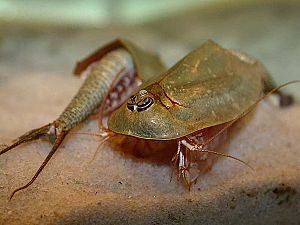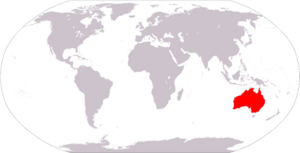Triops australiensis facts for kids
Quick facts for kids Triops australiensis |
|
|---|---|
 |
|
| Scientific classification | |
 |
|
| Where Triops australiensis lives in Australia |
The Triops australiensis, also known as a shield shrimp, is a special type of tadpole shrimp found in Australia. It belongs to a group of animals called Triops. These creatures look a bit like tiny prehistoric horseshoe crabs!
Where Do They Live?
Triops australiensis can be found all over Australia. However, you won't see them in the very northern parts of Western Australia or Queensland. They are also not found in Tasmania in the south. In Tasmania, a different kind of tadpole shrimp called Lepidurus apus lives instead.
You can tell Triops australiensis apart from Lepidurus apus by looking at their tails. Lepidurus apus has a small plate between the two tail branches at the end of its body, but T. australiensis does not.
Life and Habitat
T. australiensis lives in temporary pools of water. These pools are found in the dry, desert-like areas of the Australian outback. Imagine a place where it doesn't rain often, but when it does, puddles and small lakes form!
When these dry pools fill up with water, the special eggs of the Triops hatch. These eggs can wait for a very long time in the dry mud. Once they hatch, the tiny baby Triops (called nauplii) grow up super fast. They become adults in just a few weeks! This quick growth helps them reproduce before the temporary pools dry up again.
Adult Triops australiensis can grow to be about 3 inches (7.6 cm) long. That's quite big for a tadpole shrimp!
Water Conditions for Triops
Triops australiensis can live in water with a pH level between 7 and 9. This means they can handle water that is slightly acidic, neutral, or slightly alkaline. They can also live in both hard water (water with lots of minerals) and soft water (water with fewer minerals).
However, their eggs are more likely to hatch in water that has a low amount of minerals. This might be why they do so well in temporary rain pools, which often have less mineral content than permanent lakes or rivers.
Images for kids
See also
 In Spanish: Triops australiensis para niños
In Spanish: Triops australiensis para niños



